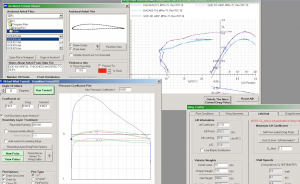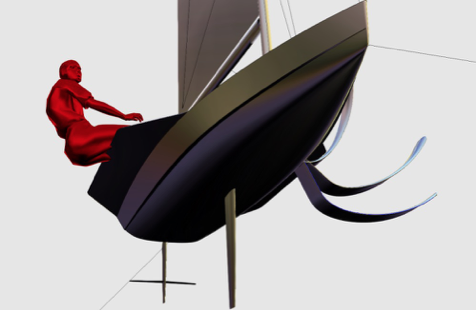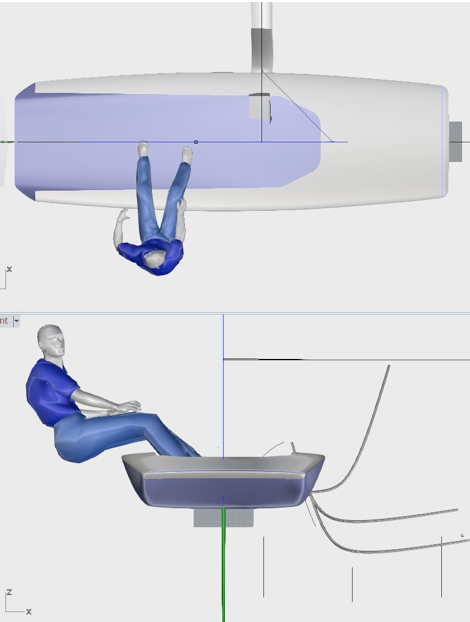4.25m Singlehanded Foiling Dinghy – by Hugh Welbourn
I was excited to discuss with Jurian the possibilities of helping him to develop a fully foiling singlehanded dinghy that would be a simple and easy way to introduce new sailors to fully flying over the water – and without the complications or extreme skills required by the likes of the Moth fraternity.
I had developed with long time clients ‘Quant-Boats’ the Q23 scow project – very much a proof of concept design that was intended to bring easy full flight into the sportboats world, and again with the fundamental requirements that any reasonably competent sailor could jump into the boat and 10 minutes later be flying.
This concept has more than proved itself over this past season – we flew the boat first time out, have taken many for their first adventure into full flight, and been overwhelmed by the interest and response that the boat has generated – now it is moving ahead into production.
So with this knowledge base in hand, to translate the first principles and proven technology down the scale into a single-handed dinghy was an irresistible challenge.
The fundamentals for the 4.25m remained the same for overall simplicity, easy and safe high speed flight, no complicated controls or systems, and the flexibility of sailing the boat in different modes to deal with variable conditions and people’s own capabilities.
Simply scaling down the Q23 was not an option, so we have developed a hull that gives us the platform for the foils, can sail with varying crew weights, and will behave predictably in difficult conditions – we don’t want the Moth experiences of nose diving and pitchpoling when you come off the foils in a seaway!
And to the foils themselves:
We have developed yet another system of handling these to suit this particular project – we need individual P&S foils to provide the stability we need, and then also to give us enough lift to support the boat and crew and be able to get airborne in relatively light conditions.
So the sizing and configuration of the foils is done with the aid of assorted high level programs and as ever we face assorted conflicts that have to be resolved.
A typical program here helps to look at various sections for the wings and the lift and drag characteristics over a range of conditions.
We have to balance lift proportions too between main wings and the rudder balancing foil, and these tools give us the means to figure out the trims and many factors that are involved in achieving stable flight.
Alongside the foil development process, a vital part of the analysis comes from the Velocity Prediction Program (VPP) in which a numerical model of the hull with rig and appendages in sailing conditions is run to provide the boat speed, heel angles, resistance factors and much other information.
This all helps to build up a picture of what the boat can do, when the foils become effective enough fly the boat, and how big the rig needs to be. A few loops around the entire process gives us the framework for the more detailed design and optimisation of the boat in general.
Eventually though we do get to a balanced design – it is important that it is comfortable to sail and that ergonomics are all tailored to make the sailing experience as easy as possible.
Ultimate speed is not the goal here – easy flight, great all-round performance, simple handling boat afloat and ashore and a forgiving platform to bring the intense experience of flying a small boat to a far wider audience than has previously been possible is what we can achieve.
– Hugh
Hugh Welbourn Design, Devon – UK





